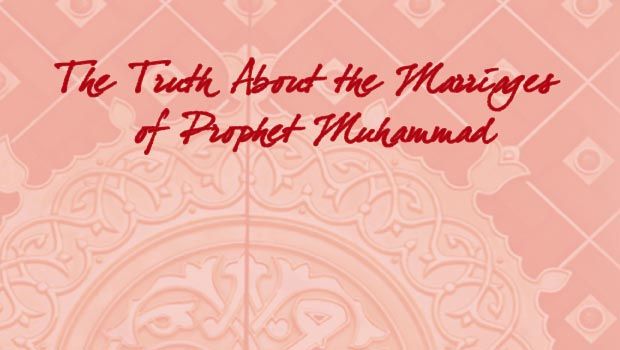For any prophet to marry and beget children is quite natural. It is the norm, not the exception (Qur’an, 13:38). The practice of polygamy by prophets throughout history is often related to their mission. Through marital bonds with different tribes and clans, prophets sought to unite various peoples and reduce or eliminate their enmity. Polygamy was practiced by many great prophets including Abraham, Jacob, David, and Solomon. According to the Bible, some of these prophets are said to have had dozens of wives and concubines.
It should be noted that when it comes to the Prophet’s conjugal fidelity, self-control, and moral excellence, there is no match. He kept his chastity as an unmarried youth, maintained real and faithful monogamy throughout the prime years of his manhood, for a full 25 years of marriage to Khadijah
Unlike adultery by those who are officially “monogamous,” polygamy in itself is not immoral. It has been practiced in many cultures throughout history. It is simply an alternative form of family structure suited to certain circumstances and social needs in different times and cultures. Examples of such needs include caring for widows and orphans following wars or dealing with demographic problems such as occasional imbalance in the gender ratio. Polygamy has been practiced as well by various religious communities, including some Jews, Christians, and Muslims.
In fact, the Qur’an is the only monotheistic Scripture that explicitly limited, restricted, and regulated the then unregulated practice of polygamy (Qur’an, 4:3, 129). Yet, due to the wide circulation of erroneous information about Islam, many have the impression that Islam introduced this form of marriage or was a unique case of allowing its practice. Among all the polygamous prophets, Prophet Muhammad is often singled out for criticism, even though he was monogamous for most of his adulthood and practiced polygamy only in the last few years of his life.
Those who try to blemish the noble character of the Prophet only impugn their own objectivity and sense of fairness
Some ask, however, why Prophet Muhammad limited his followers to a maximum of four wives, while he himself exceeded that maximum. The question itself reflects a serious misunderstanding. These limits, as well as the exception for the prophet to the limit of four, were all divine instructions revealed in the Qur’an, which to Muslims is the word of God, not the word of Muhammad. After all, the practice of unlimited polygamy was common and socially accepted in pre-Islamic Arabia. Those who believe that Muhammad himself instituted the restrictions and his own exception might ask themselves: If it were true that the Prophet wished to have more than the four wives that “he restricted” his followers to, then why did he “restrict” them in the first place? Why not “live and let live”? A related question is this: Why did the Prophet limit himself to one wife, Khadijah, for the prime time of his manhood, from the age of 25 until he was 50 years old when she died? This lengthy monogamous marriage spanning most of his marital life took place when polygamy was socially accepted and widely practiced and before any Qur’anic revelation restricting such a practice and limiting the number of wives to a maximum of four. To claim that the Prophet was untruthfully “making up” or forging verses in the Qur’an to give himself an exception, is inconsistent with his unanimously acknowledged integrity and truthfulness. It is also utterly contrary to reason.
A legitimate question, however, is this: Why did God make such an exception for the Prophet? Like some other prophets before him, Prophet Muhammad was not only a prophet, but also the leader of a community and eventually of an organized political entity. As the central personality of both faith and community, he was in a unique position to reconcile various warring peoples to one another, reconcile the hearts of his own enemies, and fulfill his mission through the most peaceful means possible. An effective way of achieving this mission in a tribal society is bonding together people through marrying women from the various tribes or clans.
This is one of the likely explanations of the Prophet’s marriage to Umm Habibah, daughter of his archenemy, Abu-Sufian. Umm Habibah migrated to Abyssinia with her husband due to persecution of the Muslims in Makkah. Her husband chose to become an apostate there and invited her to join him but she refused and remained steadfast in her faith. He later died there. The Prophet proposed marriage to her and she accepted. Besides the humanitarian gesture toward a widow without protection or support, who was already rejected by her family due to her faith, this marriage could potentially soften the heart of her father. In fact, Abu-Sufian later embraced Islam and helped avoid unnecessary bloodshed.
A similar case is his marriage to Maymounah Al-Hilaaliyyah, a woman from the Najd region who was twice married before and whose people were party to the treacherous, cold-blooded murder of seventy of the Qur’anic memorizers who were there on a peaceful educational mission. Instead of revenge and more bloodshed, the Prophet married one of their women who needed care. As a result of this kindness, her people were at least neutralized and some embraced Islam.
To reconcile the hearts of those who fought against him and to give a good example of dealing with war captives, the Prophet himself freed three women captives and offered to marry them. This act of magnanimity helped to blunt the hatred and enmity of their clans. The offer to be wives of the Prophet and become revered “Mothers of the Believers” was no small overture and quite an honor for the women and their clans. It was also a remarkable goodwill gesture by the Prophet toward those who had unfairly showed enmity to him and spared no effort in undermining his mission. Juwairiyah, Saffiyah, and Rihaanah fall into this category. In the case of Juwairiyah, the example of the Prophet freeing her resulted in an immediate action by the Muslims who freed all their captives from her tribe. Juwayriyah’s father, Al-Harith, ceased hostilities against Muslims and later embraced Islam. This illustrates one of the measures used to free those in captivity and gradually and smoothly end all existing forms of slavery, drying up even the last source of captivity — war captives.
Other marriages of the Prophet were apparently intended to cement the relationship between the Prophet and his closest friends and followers. This category includes his marriage to Aishah and Hafsah, daughters of his closest companions, Abu-Bakr and Umar. In Hafsah’s case, there was another humanitarian motive, seen in other marriages of the Prophet as well — teaching the community to take care of widows. This is especially true of the widows and orphan children of those who sacrificed their lives in defense of their faith and their community. Hafsah’s former husband, Khonays, courageously fought in the Battle of Badr and continued to fight even after he suffered serious injuries. This same motive, to provide for women whose husbands were killed in battle, is obviously behind the Prophet’s marriage to other widows such as Zainab Bint Khozaymah (who died shortly after her marriage to him) and Umm Salamah, who had four children to look after following the death of her husband. The same caring intention applies to his marriage to Sawdah, an elderly widow he married after the death of his first wife Khadijah. This marriage opened the hearts of many of her clan to Islam.
One of the Prophet’s marriages was obviously for a legislative reason — his marriage to Zainab daughter of Jahsh. Zainab was a cousin of the Prophet. He persuaded her to marry his freed slave and former “adopted son” Zaid. The apparent reason for his encouragement, in spite of her reluctance, was to break the attitude of aristocracy where a person from a noble stock would never consider marrying a commoner. The prophet sought to affirm the egalitarian nature of Islam where a person should be evaluated only on the basis of his/her qualities and moral conduct, not on the basis of his/her socio-economic status. Marital problems between Zaid and Zainab led eventually to divorce. During this time in Arabia, an adopted son was considered the same as a biological son. He would be given his adopting father’s name, a custom that the Qur’an invalidated as it demanded truthful lineal identity (Qur’an, 33:4-5; 40). Since this custom of giving an adopted son the father’s name was so entrenched in the society, the Prophet was the perfect exemplar to implement the new divine law. A careful study of the Qur’an describes such a reason. It indicates that the Prophet was commanded to initiate this change in a practical manner by marrying Zainab, the divorcee of his former “adopted son” Zaid (Qur’an, 33: 37-39). Since a man is prohibited from marrying the former (divorced) wife of his biological son, the marriage to Zainab established the fact that an “adopted son” is not the same as a biological son. Some writers forsook the most authentic source of the Prophet’s life, the Qur’an, in favor of auxiliary narrations reported by generally reliable historians, narrations which, nonetheless, must be considered as less than authentic since they contradict the Qur’an. According to these various narrations, often contradictory in details one to another, Zaid divorced his wife so that the Prophet could legitimately marry her. Aside from the in authenticity of the story and its contradiction to the Qur’anic explanation, it is totally illogical. Zainab, after all was a cousin of the Prophet and he saw and knew her for decades as a close relative. She would have been most honored to marry the Prophet if he wished that. Why would the Prophet persuade her to marry his former slave and “adopted son,” then have Zaid divorce her so that the Prophet could marry her? Why not simply marry her rather than encouraging her marriage to another man?
Another criticism of the Prophet relates to his marriage to Aisha, daughter of his companion Abu-Bakr. Some point out that in the collection of hadeeth by Bukhari, Aisha reported that her marital contract took place when she was six years old, and that she did not live with the Prophet until three years later, after migration to Madinah. Some refer to this marriage as “child molestation” or “pedophilia.” One wonders how such a well-to-do respectable father as Abu-Bakr would give his beloved daughter Aisha to be “molested” and with the blessings of her own mother? And how come none of the watchful critics and archenemies of the Prophet during his own time ever raised any question about this marriage, even though they were, like some of today’s critics, eager to find any fault that could discredit the Prophet? This signifies that the marriageable age in that culture at that time, a sin in other cultures and times as well, including in medieval Europe, considered reaching puberty as an acceptable age for marriage. The fact that there was a three-year gap between the marital agreement and the dwelling of Aisha with the Prophet seems to support the existence of this custom. In fact, Aisha was engaged to another person before her parents decided to marry her to the Prophet instead. This shows how common this practice was. Needless to say, the successive increase of the minimum marriageable age after reaching puberty is based on cultural and social norms, which are subject to change with time, culture, and other circumstances.
It should be noted that the special exception to the Prophet concerning the maximum number of wives (Qur’an, 33:50) includes also special restrictions on him and his wives regarding allowances available to all others. For example, his wives, as “Mothers of the Believers,” were not allowed to remarry after him (Qur’an 33:53). If the Prophet were required to divorce wives beyond the maximum of four, it would have done them injustice —these women would be divorced yet disallowed to remarry. Furthermore, for each of the Prophet’s marriages there was a specific lesson, social or legislative, as discussed above. By divorcing any one or more of his wives, those lessons would effectively be negated, especially the unifying function of marrying women from different clans and backgrounds. This diversity allowed close observation of his private life and teachings by women from the various tribes who would then communicate them to their respective folk. Also, unlike any other Muslim, the Prophet was not allowed to divorce any of his wives and marry others (Qur’an 33:52).
In conclusion, it should be noted that when it comes to the Prophet’s conjugal fidelity, self-control, and moral excellence, there is no match. He kept his chastity as an unmarried youth, maintained real and faithful monogamy throughout the prime years of his manhood, for a full 25 years of marriage to Khadijah. Even when he practiced polygamy, he did so for humanitarian and reconciliatory reasons, and only in the last few and waning years of his life. His extraordinary schedule and responsibilities, his regular lengthy night prayers, his amazing achievements in such a short time, all that precludes any notion of obsession with worldly pleasures. Supporting and protecting women, especially older widows and their children, within the context of marriage, is necessarily and undoubtedly from a motive other than a sensual one. Those who try to blemish the noble character of the Prophet only impugn their own objectivity and sense of fairness. May Allah cure their hearts from hatred borne of ignorance and pre-conceived stereotypes; and may He guide all whose hearts are open to learning from the inspiring lives of the great prophets. Peace be upon all human beings who follow the guidance of God, manifest His love in deeds as much as in words, and sincerely promote human fellowship and mutual understanding.






